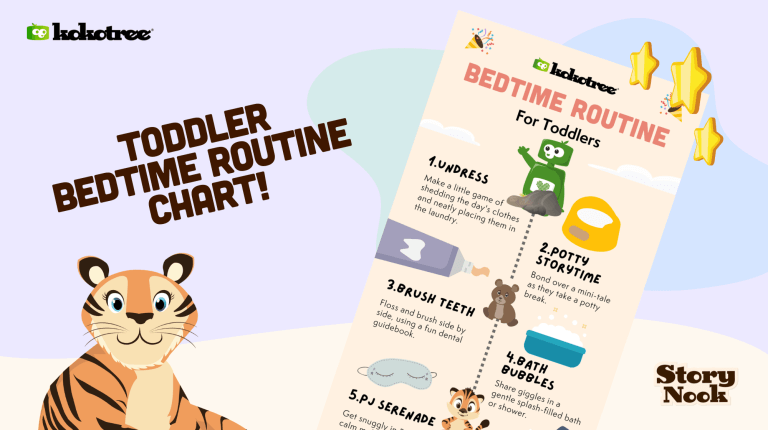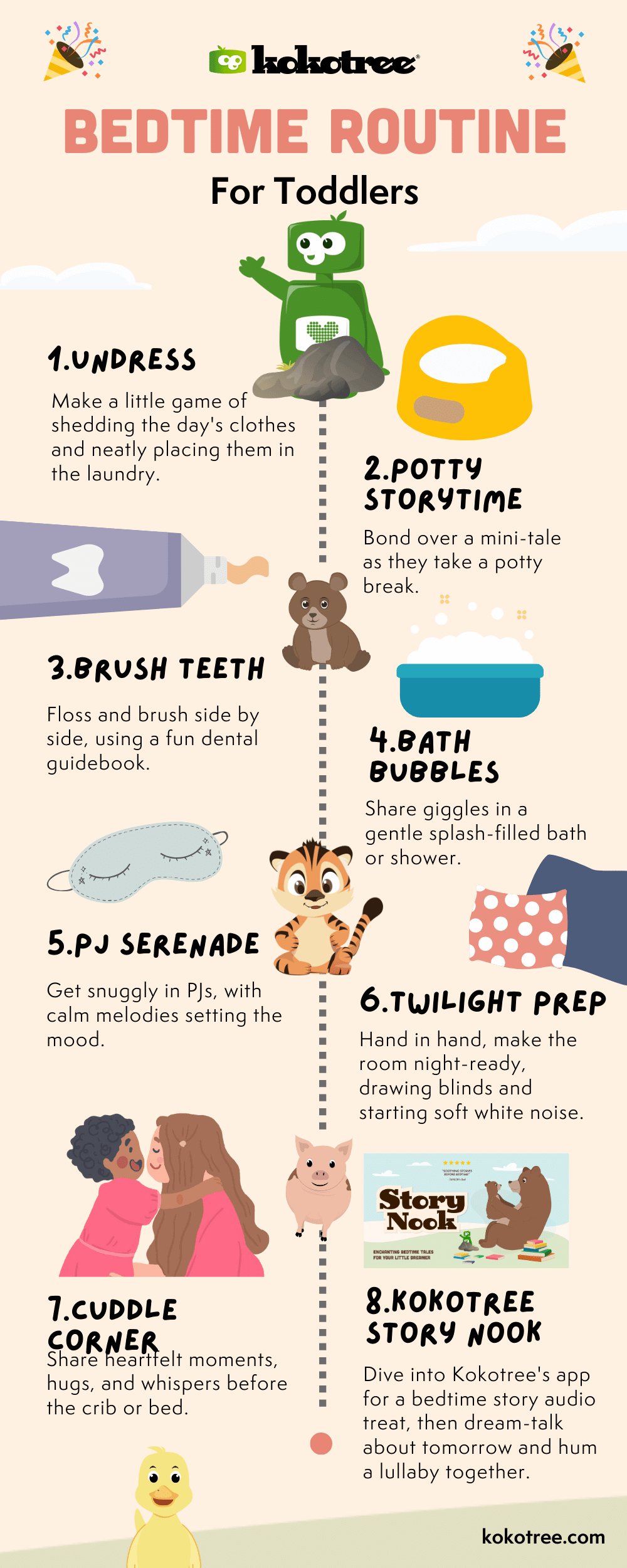

Bedtime routines are more than just activities leading up to lights out. They play a pivotal role in a child’s overall development. A structured bedtime routine ensures your child gets adequate sleep and fosters a sense of security, routine, and predictability.
At Kokotree, we believe bedtime is more than just a cue to wind down the day; it’s a sacred time for parents and toddlers to strengthen their bond. Drawing from timeless rituals and modern insights, we’ve crafted a bedtime routine that intertwines the warmth of age-old traditions with the enchantment of today’s storytelling.
The Kokotree bedtime routine is designed to nurture connection, foster a love for stories, and pave the way for a serene night’s rest.

Creating a bedtime routine for your toddler can be a game-changer. Not only does it pave the way for better sleep, but it also fosters a sense of security and routine in your child. Here’s a step-by-step guide to help you establish an effective bedtime routine:
Before creating a routine, take a moment to understand your child’s unique needs. How much sleep do they require? Are there specific activities they particularly enjoy or dislike before bed?
Choose a realistic bedtime for your family’s schedule and stick to it. Consistency is key. Over time, your child’s internal clock will adjust, making it easier for them to fall asleep at the set time.
Ensure the bedroom is conducive to sleep. This might mean dimming the lights, reducing noise, or using blackout curtains. A calm environment signals to the child that it’s time to wind down.
At least an hour before bedtime, turn off TVs, tablets, and other electronic devices. The blue light emitted by screens can interfere with the production of melatonin, a hormone that regulates sleep.
Choose activities that help your child relax. This could include:
A light snack can help ensure your child doesn’t go to bed hungry. Opt for something easy to digest, like a banana or a small glass of milk.
Incorporate activities like brushing teeth, washing hands and face, and taking a warm bath. Not only do these promote good hygiene, but they also signal to the child that bedtime is approaching.
Ensure your child is dressed in comfortable pajamas suitable for the season. Avoid tight-fitting clothes or those with tags that might cause discomfort.
As your child grows, encourage them to take on more responsibilities during the routine. This could mean letting them choose the bedtime story or allowing them to brush their teeth on their own.
Especially if your child is transitioning to sleeping alone, offer reassurance. A comforting word, a cuddle, or even a favorite soft toy can make a world of difference.
While it’s okay to tweak the routine as your child grows or as circumstances change, try to stay consistent with the core activities and timings. This consistency reinforces the routine and makes it more effective.
Remember, establishing a routine takes time. There might be days when your child resists or when things don’t go as planned. Approach such challenges with patience and understanding.
By following these steps and tailoring them to your child’s unique needs, you can create a bedtime routine that ensures better sleep, fosters independence, and strengthens the bond between you and your child.
✨ How to Create a Bedtime Routine for Toddlers and Preschoolers: Embark on a journey to craft the optimal nighttime routine that both ensures a restful slumber and fuels your little one’s growth.
🌌 How Bedtime Stories Help Kids Learn Routines and Structure: Dive into the transformative realm of evening tales and grasp their crucial role in nurturing routine, structure, and life-enhancing skills in children.
🎵 Introducing Story Nook: Bedtime Stories Come Alive with Kokotree!: Envelop your child in an auditory wonderland with our curated collection of bedtime audio tales, perfect for those cherished moments of connection.
While the primary goal of a bedtime routine is to facilitate better sleep, its benefits extend far beyond that. Regular bedtime activities stimulate cognitive development, enhance language skills, and promote emotional growth. When a child knows what to expect at the end of the day, it reduces anxiety and fosters a sense of stability.
Across cultures, certain bedtime activities remain constant. Reading a bedtime story, singing a lullaby, or simply talking about the day are universal rituals that children across the globe find comforting. These activities pave the way for better sleep and offer a platform for parent-child bonding.
As children grow, their needs change. While a lullaby might soothe a toddler, a preschooler might prefer a story or a chat about their day. Adapting the bedtime routine to suit your child’s age and preferences is essential, ensuring it remains effective and enjoyable.
A well-structured bedtime routine signals to the child that it’s time to wind down. Activities like reading or listening to calm music help transition from the hustle and bustle of the day to a more relaxed state, making it easier for the child to fall asleep.
The benefits of a consistent bedtime routine spill over into other areas of a child’s life. Regular routines foster a sense of discipline, enhance cognitive abilities, and even affect emotional and behavioral regulation. For instance, a child accustomed to a bedtime story might develop a love for reading, which can significantly boost their literacy skills.
One of the most overlooked benefits of bedtime routines is their opportunity for parent-child bonding. Those quiet moments, whether reading a story or simply cuddling, can strengthen the emotional connection between you and your child, laying the foundation for a trusting relationship.
It’s not uncommon for parents to face resistance when trying to establish a bedtime routine. Toddlers and preschoolers, with their newfound sense of independence, might rebel against the idea of going to bed. It’s essential to approach such challenges with patience and understanding.
Consistency is key. Even if your child resists, sticking to the routine is crucial. Over time, they’ll come to appreciate the predictability. Additionally, involve your child in the process. Let them choose the bedtime story or the lullaby. They’re more likely to cooperate when they feel a sense of control.
While establishing a bedtime routine might require effort and patience, the immediate and long-term benefits are well worth it. As a parent, you have the unique opportunity to shape your child’s early experiences, and a positive bedtime routine can set the stage for a lifetime of good habits and fond memories.




